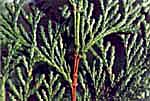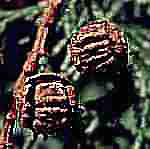
Bark on a 25 cm dbh tree in the Seattle arboretum. Image width 25 cm [C.J. Earle].

Foliage detail and transition from 1-yr to 2-yr old foliage on a tree in the Seattle arboretum. Twig diameter 2 mm [C.J. Earle].

Two 9 mm diameter cones on a tree in the Seattle arboretum [C.J. Earle].

Natural forest of Chamaecyparis obtusa in Nagano (6).
Common Names
HINOKI, FINUCHI (Japanese) (2), hinoki cypress.Taxonomic notes
Syn: Retinospora obtusa Sieb. & Zucc. 1870 (1).One variety, formosana (Hayata) Rehder 1914, synonyms for which include C. obtusa Sieb. & Zucc. forma formosana Hayata 1908; and C. taiwanensis Masamune & Suzuki 1923. The difference between the variety and the type is nearly as great as the difference between Ch. pisifera and Ch. formosensis, and it similarly differs in climatic and ecological adaptation; it may be better treated at specific or at least subspecific rank.
Description
Trees to 40 m high and 3 m in diameter, the trunk straight, bark reddish brown, fibrous, fissured into thin strips. Branchlets slender, closely arranged in one horizontal plane. Leaves subulate on seedlings, then scale-like, densely imbricate, closely appressed, dark green above, with white marks beneath, the apex obtuse, often keeled. Mature cones globose, 8-12 mm in diameter, the scales 8-10, each scale smoothly rounded and minutely mucronate, the apical pair of scales fused. Seeds about 3 mm long, narrowly winged, about 4 mm in diameter (2, 5, 8). The var. formosana differs in smaller cones, 7-9 mm, and scales with a small central depression (8).Range
Southern Japan (2), USDA hardiness zone 6. The variety in Taiwan, USDA hardiness zone 8.Var. formosana reported for Taiwan: Hualien, Ilan and Xinchu Xians, esp. Yuanyanghu (Lake) Nature Preserve (121:24E, 24:35N). Elevation 1600-2900 m. Mesic mixed Chamaecyparis and broad-leaved forest; also exposed sites at high elevation (4).
Big Tree
Oldest
Dendrochronology
Ethnobotany
HINOKI means"fire tree"; it was used to make fire by friction, a practice still employed at Shinto shrines (2).It is one of the 'Five sacred Trees of Kiso' in Japan, the others being Ch. pisifera, Thuja standishii, Thujopsis dolabrata and Sciadopitys verticillata (7).
Observations
Remarks
Citations
(1) Silba 1986.(2) Walker 1976.
(3) Michener, David C. at the Flora of North America web site.
(4) Botanical Inventory Of Taiwan.
(5) Li 1975.
(6) Forestry and Forest Products Research Institute (FFPRI). Apr-1996 (accessed 12-Oct-1998). Introduction to Forestry And Forest Products Research Institute. URL: http://ss.ffpri.affrc.go.jp/outline.html.
(7) Dallimore et al. 1967.
(8) M.P. Frankis, personal observations communicated 3-Feb-1999.
This page co-edited with M.P. Frankis, Feb-1999.
[Chamaecyparis] [Cupressaceae] [home]
This page is from the Gymnosperm Database
URL: http://www.geocities.com/~earlecj/cu/ch/obtusa.htm
Edited by Christopher J. Earle
E-mail:earlecj@earthlink.com
Last modified on 27-Feb-1999